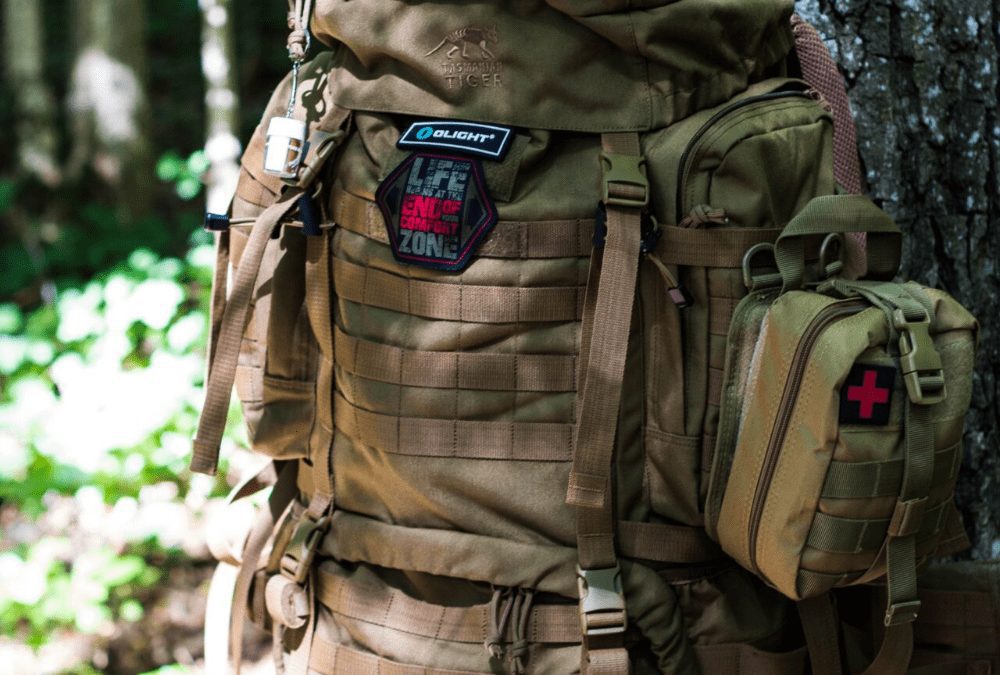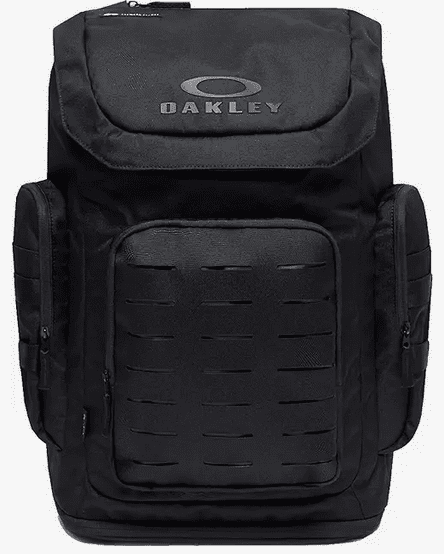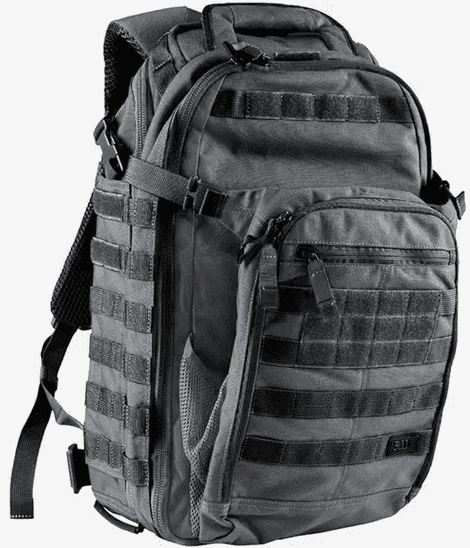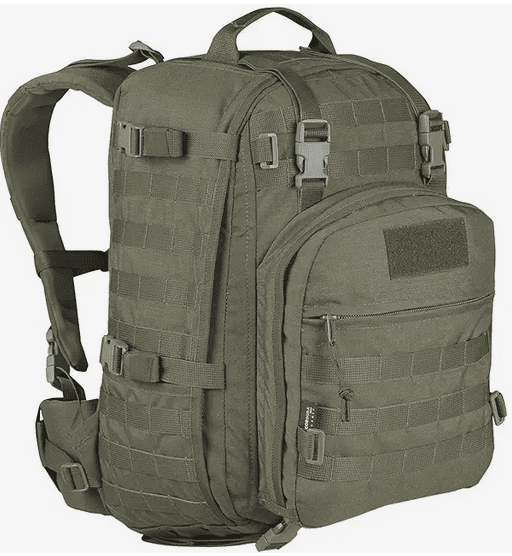If you take your outdoor fun seriously, you need a reliable rucking backpack that can carry all of your gear and allows you to get into peak shape as quickly as possible. Rucking backpacks are a play on the military term “rucksack,” or backpacks that you wear while out in the field.
The military often uses rucking backpacks for training exercises, often loading up the rucks with 50 pounds or more of gear. The idea, of course, is to train your body to get used to carrying around a lot of extra weight, which is helpful for combat missions and fighting fatigue in battle.
Even if you’re a civilian, you can still use a rucking backpack to train. When selecting the rucking backpack that’s best for you, try to find a pack that has padded shoulders so that your back and arms don’t hurt under the strain.
The best options are also heavily reinforced and have supportive padding on the back that gives you a good buffer between your body and the pack itself. Keep an eye out for durable materials as well, like canvas, nylon, and even leather. Take a look at some of our top rucking backpacks!
Table of Contents
Rucking Backpack Defined
What to Look for in a Rucking Backpack?
Other Rucking Considerations
Our Top Backpacks for Rucking Picks
Frequently Asked Questions
Rucking Time?
What is a Rucking backpack?
A rucking backpack is a type of backpack designed for rucking, which is a form of exercise that involves walking or hiking with a loaded backpack. Rucking backpacks are typically made of durable materials and feature a padded back panel and shoulder straps for comfort during extended periods of wear.
They also have additional features such as MOLLE webbing for attaching additional gear and hydration ports for carrying water bladders. Rucking backpacks are often used by military personnel and fitness enthusiasts as a way to increase strength and endurance.
What to Look for in a Rucking Backpack Before Purchasing
If someone is looking to purchase a rucking backpack, there are several important factors to consider. Here are some things to look for:
-
Durability: A rucking backpack should be able to withstand the rigors of carrying heavy loads over long distances. Look for a backpack made with high-quality materials such as reinforced nylon or Cordura.
-
Comfort: Since rucking involves carrying a heavy load over long distances, it’s important to have a backpack that is comfortable to wear. Look for backpacks with padded straps, a waist belt, and a chest strap to distribute weight evenly and prevent discomfort.
-
Capacity: Consider the size of the backpack and its capacity. Depending on your needs, you may need a larger or smaller backpack. It’s important to choose a backpack that can comfortably carry all your necessary gear.
-
Weight: Since rucking involves carrying a heavy load, it’s important to choose a backpack that is lightweight to begin with. Look for backpacks that are made with lightweight materials and have a minimal design.
-
Accessibility: Look for backpacks with easy-access pockets and compartments to make it easy to access items you need on the go.
-
Hydration: Since rucking can be a strenuous activity, it’s important to stay hydrated. Look for backpacks with hydration bladder compatibility or built-in hydration systems.
-
Price: Rucking backpacks can range in price from under $50 to over $500. Consider your budget when choosing a backpack and look for a high-quality backpack that fits within your price range.
Other Rucking Considerations
Wide, overly padded shoulder straps
A wide strap spreads weight over the shoulders instead of putting the stress in a single place. The most common area where most rucking packs break, is usually shoulder straps. A simple addition of reinforced straps will increase the lifespan of your packs greatly. Plus the added benefit of a padded comfortable fit will help you ruck for miles on end.
Quality materials
If you plan on using your rucking pack for a routine, you will have to use the right quality material. It will suffice to buy more than 500 D cordura. The waterproof coating helps the pack last a lifetime when worn. A further important point should be checked for the heavy reinforced stitched straps and a bodyweight strap such as shoulders straps or zipper track. As you get older and stronger, the weight gain and the distance can increase. If stress points or material costs are low, your rucksack won’t last long.
Does the rucksack have enough MOLLE webbing for your needs?
The various MOLLE pouches are commonly used to carry ammunition, gas masks, batons, flares, grenades, handcuffs and pepper spray. For your training purposes they can be used to hold water bottles or various weights and other items you might need for your ruck march. Molle webbing is typically stitched into a shoulder strap or a piece of woven clothing for added support. Using the well crafted bags you have easy access from pouch to bladder with sturdy straps. No one wants a sagging pouch or pocket while on a ruck walk or run.
Does it include a rucking weight pocket?
Make sure to find a good backpack that will protect your heavy loads during the move. A backpack designed to be used for trekking has reinforced sizing pockets that are designed specifically for distributing weight such as a lighter pocket for carrying heavier items. You need the assurance that your ruck will withstand high loads during a race, march or training.
Water storage options (water bottle holder or water bladder pocket)
Keeping water bottles in your rucksack will be needed to stay hydrated during your rucking outing. It’s important to have a ruck that can hold a minimum of one water bottle with quick and easy access to. If you like camelbacks, find a ruck with a hydration bladder. Aside from that, you should use a water bottle bag or a MOLLE woven webbing that holds the internal bottle pocket.
Heavy duty nylon stitching
If you are able to test your rucksack before purchase, give it a tug at the seams. Make sure it feels solid and there are no lose stitches. Carrying weight while training means you need high quality nylon stitching to hold up to the riggers of the environment and the abuse you will put your rucksack through.
Does the rucksack have a history of solid reviews?
When deciding on hiking or tactical backpack, you should read reviews. Start by reading reviews on the manufacturer’s website; see the reviews from military members and current military personnel. This is going to give you an understanding of the long-term durability of the hiking/rucking backpack. Moreover, look for daily reviews by customers. From a regular person’s point of view, the perspective of others might provide more insight into small things such as the comfort of space and ease of use that are often overlooked in large studies.
Protected laptop compartment (optional)
The use of the backpack is important for everyday tasks and allows you to take the backpack in your hands. Laptops’ protected compartments should always be a necessity in all cases. If you want to go hardcore, look for ones with a bombproof laptop compartment. This is more for active duty soldiers carrying a tactical backpack or everyday carry bag.
Aim to start with a smaller 20L to 30L for a daypack
If your just beginning to train, start with a smaller alice pack or rucking packs that are in the 20L-30L size. Once comfortable and your endurance and stamina have been built, move on to a larger backpacks for rucking that can carry heavier loads with even weight distribution.
Padded Hip Belt
Look for a ruck with a padded hip belt. Depending on the amount of weight you would like to train or carry, it’s nice to have a 3rd point of contact to the body other than the shoulders. Make sure the hip belt is comfortable and doesn’t dig into your hips. Look for one that’s adjustable and will not slacken as you get further into your hike.
Our Top Choices for the Best Backpacks for Rucking
M-Tac Elite Tactical Backpack For Rucking
The M-Tac Elite Rucksack emerges as the quintessential backpack for rucking and hiking, catering to outdoor enthusiasts and tactical professionals alike. Boasting a 25L capacity and dimensions of 20″ x 11″ x 7″, this backpack combines a convenient design with robust construction, making it the go-to choice for those on the move.
One of its standout features is the innovative design that allows the backpack to open like a suitcase, facilitating effortless packing and organization of gear. The flip cover of the main compartment features a large hook velvet panel for attaching various organizers, such as medical pouches, and a dedicated laptop compartment with a fastex buckle for up to a 15.6″ diagonal size.
Crafted from elite-quality materials, the M-Tac rucksack is constructed with Cordura 500D, a wear-resistant and rugged material that can withstand harsh outdoor conditions. MIL-SPEC straps, YKK zippers, and WJ hardware contribute to its maximum durability and reliability, ensuring it can stand up to the demands of rugged terrains.
Comfort is paramount in the Elite Rucksack, featuring a stiffening insert at the back for comfortable carrying even when loaded with heavy gear. The soft mesh shoulder straps and back panel work together to reduce strain on your back and shoulders. The adjustable chest belt with a quick-release fastener allows for a customizable fit, ensuring maximum comfort during extended rucking or hiking sessions.
The multipurpose design of this backpack is highlighted by the Molle system, enabling the attachment of additional pouches or tactical equipment to customize and expand carrying capacity based on specific needs. Side compression straps add another layer of versatility, allowing you to compress your load for better stability and balance.
In summary, the M-Tac Elite Rucksack stands out as a top-tier choice for outdoor enthusiasts seeking a reliable, well-designed backpack for rucking and hiking. Its combination of innovative features, elite-quality materials, and thoughtful design make it an indispensable companion for any adventure.
Mystery Ranch Rip Ruck
The Mystery Ranch Rip Rucksack, particularly the Rip Ruck 32, stands out as a fantastic choice for individuals seeking a high-quality rucksack that excels in both durability and functionality.
At its core, the Rip Ruck 32 boasts a spacious design with two main compartments, providing a dedicated zip access to a separate laptop and document sleeve. The inclusion of a zippered mesh pocket further enhances its organizational capabilities, ensuring ample space for all your essentials and must-haves.
The durable design of the Rip Ruck is a testament to its military-inspired roots, blending organization and access features developed for military use. This not only speaks to its robust construction but also positions it as a versatile professional carryall and an ideal travel companion.
A standout feature is the Quick Rip-Zip access, a tactical innovation that enables rapid access to the contents of the backpack. The rip-zip opening facilitates volume expansion, and the weather protection zippers with urethane ensure that your gear remains secure and shielded from the elements.
Storage and organization are key strengths of the Rip Ruck, featuring built-in side stretch-woven pockets, PALS webbing, and a daisy chain for attaching accessories. Additionally, the inclusion of four exterior pockets enhances its storage capacity, making it a reliable companion for those with diverse carrying needs.
True to Mystery Ranch’s commitment to quality, the Rip Rucksack is built for the mission. The use of the best materials available and the implementation of the most durable construction methods ensure that this gear will reliably support your mission, no matter the challenges you face.
In summary, the Mystery Ranch Rip Rucksack, particularly the Rip Ruck 32, is a top-tier choice for individuals seeking a high-quality rucksack. Its thoughtful design, durable construction, quick access features, and ample storage capacity make it a fantastic option for those who prioritize reliability and functionality in their gear.
Frequently Asked Questions
Can you use any backpack for rucking?
Technically, you can use any backpack for rucking. However, not all backpacks are designed to withstand the stresses and strains of rucking. Rucking involves carrying heavy weights for long distances, which can put a lot of strain on the backpack and your body.
A proper rucking backpack will distribute the weight evenly across your body, have padded shoulder straps and hip belts for added comfort, and be made of durable materials that can withstand the wear and tear of rucking. So while you can use any backpack for rucking, it is important to choose one that is specifically designed for this activity for the best experience and to avoid potential injury or damage to the backpack.
What makes a good rucking backpack?
A good rucking backpack should have several key features to ensure it can withstand the weight and rigors of rucking. Some important features to look for include:
- Durability: The backpack should be made of high-quality materials that can withstand the wear and tear of rucking.
- Capacity: The backpack should have enough capacity to hold all the necessary gear and weight for your ruck.
- Comfort: The backpack should have padded straps and back panel to provide comfort during the ruck. It should also have a chest and waist strap to help distribute the weight evenly.
- Hydration system: The backpack should have a hydration system, such as a bladder or water bottle pockets, to allow you to stay hydrated during the ruck.
- Molle system: The backpack should have a Molle system, which allows you to attach additional gear or pouches to the backpack.
- Weight: The backpack should be lightweight to reduce unnecessary weight during the ruck.
- Price: A good rucking backpack can be expensive, but you should aim to get the best value for your money by choosing a durable and high-quality backpack that will last a long time.
Overall, a good rucking backpack should be durable, comfortable, have the right capacity, and include features that allow you to easily carry and access gear during the ruck.
What do you put in a rucking pack?
When rucking, what you put in your backpack depends on your goals and the distance you plan to cover. Here are some items that are commonly included in a rucking pack:
-
Weight: The weight you add to your backpack will depend on your goals and fitness level. A good rule of thumb is to start with 10% of your body weight and work up to 20-30% over time.
-
Water: Staying hydrated is crucial, especially on longer rucks. A hydration bladder or water bottle is a must-have.
-
Snacks and fuel: You’ll need to fuel your body with snacks and energy gels to keep your energy levels up during your ruck.
-
First aid kit: A small first aid kit can come in handy for minor injuries like blisters and cuts.
-
Navigation: Depending on where you’re rucking, you may need a map, compass, or GPS device to help you navigate.
-
Extra clothes: If you’re rucking in inclement weather or for an extended period of time, you may need extra clothes to stay comfortable.
-
Headlamp: If you’re rucking in the dark, a headlamp can be a valuable tool to light your way.
-
Communication device: If you’re rucking alone, it’s a good idea to have a way to communicate in case of an emergency.
It’s important to remember that the weight in your rucking pack should be distributed evenly and fit comfortably on your back.
What muscles does rucking work?
Rucking is a full-body workout that engages various muscles, including the legs, glutes, core, and upper body. The primary muscles worked during rucking are the legs, including the quadriceps, hamstrings, and calves, as they are used to propel the body forward while carrying weight.
The glutes and hips are also heavily engaged during rucking, especially during uphill climbs. Additionally, the core muscles, including the abdominals and lower back, are activated to maintain stability and balance while carrying a heavy pack. The upper body muscles, including the shoulders, arms, and back, are also engaged to support the weight of the pack and maintain proper posture. Overall, rucking provides a challenging and effective full-body workout.
What is the best weight for rucking?
The best weight for rucking depends on your fitness level, experience, and goals. Generally, beginners should start with a lighter weight, such as 10-20 pounds, and gradually increase as they get stronger and more experienced.
A good rule of thumb is to aim for 10% of your body weight, but this can vary depending on your goals and the difficulty of the terrain. It’s important to listen to your body and start with a weight that feels comfortable and safe, and gradually increase as you feel ready. It’s also important to use proper form and technique to prevent injury.
Rucking Time?
Choosing the right rucking backpack is important for anyone who wants to embark on hiking or training with weight. A good rucking backpack can provide the necessary support, comfort, and durability needed for carrying heavy loads over long distances. When selecting a rucking backpack, factors such as size, weight, capacity, durability, and comfort should be carefully considered to ensure that it meets the user’s needs and preferences.
By taking the time to find the right rucking backpack, hikers and fitness enthusiasts can have a successful and comfortable experience on the trails or during their training sessions.










